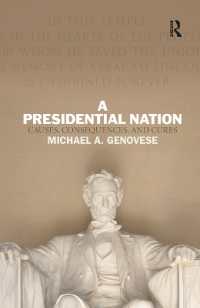- ホーム
- > 洋書
- > 英文書
- > Religion / Ethics
Full Description
In this book, Joseph Citron offers the first comprehensive analysis of Prague Rabbi Isaiah Horowitz's (c.1565-c.1626) magnum opus of Jewish ethical literature, the Shnei Luhot Ha-Berit. Citron's close philological analysis reveals the pioneering nature of the work in creating an organic Jewish theological system rooted in the mystical structures of Kabbalah, cultivating an orthodoxy in thought and legal practice based upon its principles. It provided a platform for laypeople to attain great spiritual heights by emphasising that God could be served and cleaved to through mundane activity, and that Judaism demanded deep emotion and joy as much as Talmudic erudition or meticulous observance. The Shelah's paradigms significantly influenced 17th-century Sabbatean movement, the 18th-century Hasidic movement, and Jewish Orthodoxy in the 19th century. The book is essential for scholars and laypeople alike wishing to understand the evolution of Judaism in Central and Eastern Europe in the early modern period.
Contents
Acknowledgements
part 1: Introduction
1 Generalities
1 Methodology and Organisation
2 Biography
3 The Shelah in Secondary Literature
4 Key Concepts
2 The 'Threefold Cord': The Shelah's Structure and Methodology
1 Audience
2 Composition
3 'The Threefold Cord'
4 Author's Methodology and Limitations
part 2: Kabbalah
3 Kabbalah as Jewish Theology
1 The Essence of Judaism
2 The Organic Universe
4 The Shelah's Kabbalistic Sources and Central Tenets
1 The Sources
2 Central Tenets: Creation
3 Man, God and the Torah
4 The Fall and Redemption of Man
5 Self-Actualisation
6 Providence and Divine Justice
7 ʿAvodah le-Tsorekh Gavohah
8 Torah Study
5 Orthodoxy and Jewish Particularism
1 Orthodoxy
2 Heresy without Heretics
3 Particularism
6 Devekut
1 Background
2 Devekut in the Shelah
3 The Ladder of Devekut
4 Extraordinary Devekut
Part 3: Halakhah
7 Kabbalistic Halakhah 1: Theory
1 Halakhah as Prophecy
2 Charismatic Authority
8 Kabbalistic Halakhah 2: Practice
1 Ordinary and Elitist Applications of the Halakhah
2 Kabbalah and Halakhah in the Shelah
3 Minhag
9 The Pathway to Pietism
1 Incomplete Halakhah
2 Mikveh and Holiness
10 Stringency and Elitism
1 Stringency and Leniency in Halakhah
2 Stringency as the Antidote for the Serpent
3 'One Who Is Stringent Will Merit Blessing'
4 Ner Mitsvah as Pietism
Part 4: Musar
11 'In All Your Ways Acknowledge Him': The Two Paths of the Righteous
1 Asceticism and the Ideal of Righteousness
2 Between Heaven and Earth: The Tsaddik
3 Sanctification of the Body
12 The Primacy of Joy
1 Background
2 Joy and Enthusiasm in the Shelah
3 Prayer and Joy
13 Messianic Self-Transformation
1 The Transformation of Evil
2 Tikkun
Part 5: Conclusion
Conclusion
Epilogue: Isaiah the Prophet
1 Antinomianism
2 Orthodoxy
3 Hasidism and Pietism
4 Texts
Bibliography
Manuscripts
Primary and Secondary Literature
Index







